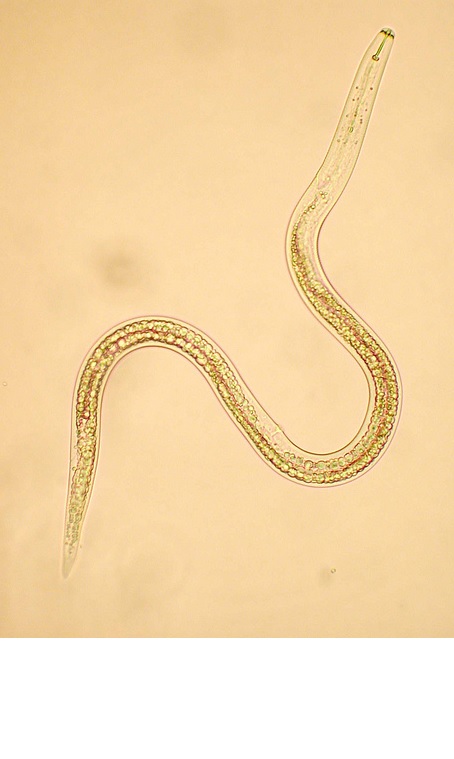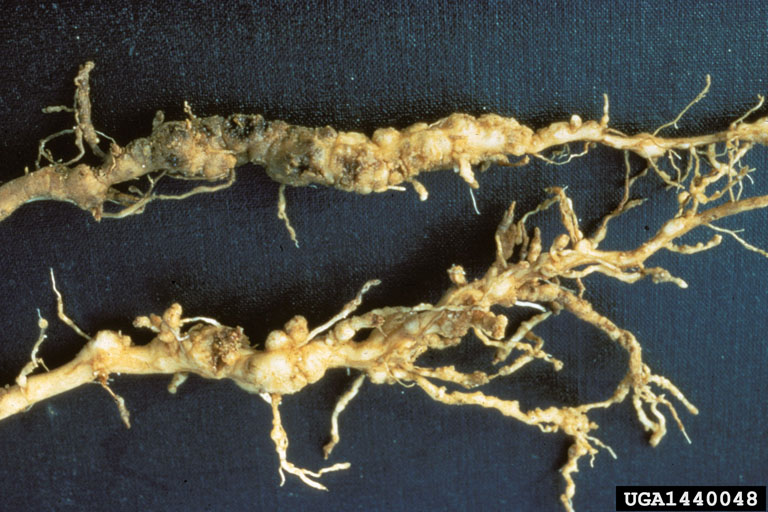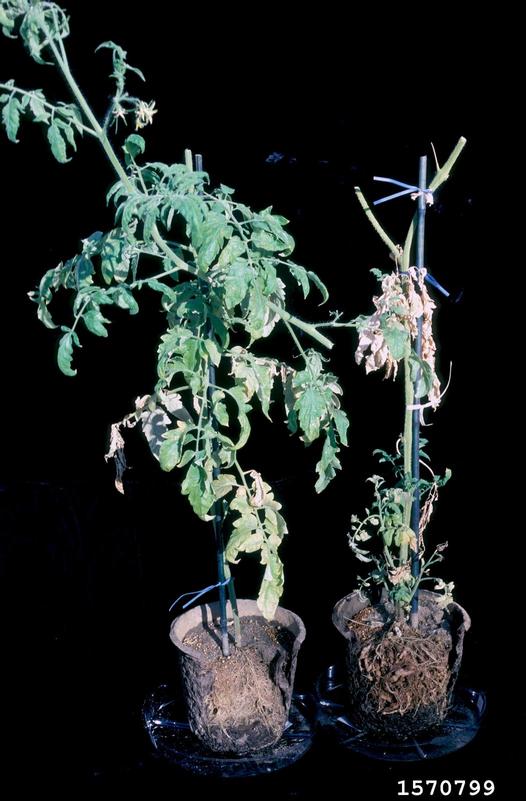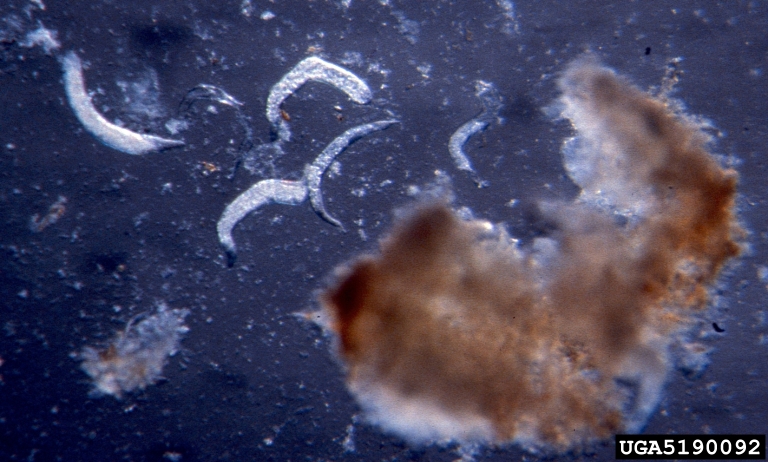 Root Knot Nematodes - July 1, 2015 Jeff Schalau, Agent, Agriculture & Natural Resources University of Arizona Cooperative Extension, Yavapai County Nematodes are microscopic roundworms. Some nematodes are considered beneficial because they parasitize soil dwelling insect larvae that damage crops and ornamental landscape plants. You may have seen these listed in garden catalogs as Steinernema spp. and Heterorhabditis spp. Other nematodes are serious crop pests. Root knot nematodes (Meloidogyne spp.) are the most destructive nematode species in agricultural and landscape settings. Worldwide, it is estimated that they cause up to $100 billion in damage per year. While they are not native to Arizona, they have been introduced and are present in some areas of the Verde Valley. Root knot nematodes attack a wide range of plants, including many common vegetables, fruit trees, and ornamentals. They are extremely difficult to control and can be spread easily from site to site in soil (for example, on tools, boots, etc.) and plant material. Root knot nematodes usually cause distinctive swellings, called galls, on the roots of affected plants. Infestations of these nematodes are fairly easy to recognize by digging up a few plants with symptoms, washing or gently tapping the soil from the roots, and examining the roots for galls. The nematodes feed and develop within the galls, which may grow to as large as 1-inch in diameter on some plants but are usually much smaller. The water- and nutrient-conducting abilities of the roots are impaired by the formation of the galls. Galls may also crack or split open, especially on the roots of vegetable plants, allowing the entry of disease-causing microorganisms. Symptoms of a plant infected with root knot nematodes include wilting, loss of vigor, yellowing, and other symptoms similar to a lack of water or nutrients. Infected vegetable plants grow more slowly than neighboring healthy plants and symptoms often appear beginning in early to midseason (May to July). Plants often wilt during the hottest part of the day, even with adequate soil moisture, and leaves may turn yellow. Leaves are fewer and smaller, fruits production is diminished, and plants in heavily infested areas may even wilt and die. Damage is most serious in warm, regularly irrigated, sandy soils. Root knot nematodes go through six stages: an egg stage, four immature stages, and an adult stage. Many species can develop from egg to egg-laying adult in as little as 21 to 28 days during the warm summer months. Immature stages and adult males are long, slender worms. The mature adult females of root knot nematode change to a swollen, pear-like shape. The nematodes are too small to be seen without the aid of a microscope, so diagnosis is usually done by observing root symptoms. Management of root knot nematodes is difficult. The most reliable practices are preventive, including sanitation and selection of resistant plant varieties. Nematodes are usually introduced into new areas with infested soil or plant materials. Purchase nematode-free plants from reliable nurseries. To prevent the spread of nematodes, avoid moving plants and soil from known infested areas to other parts of the garden. Do not allow irrigation water from around infested plants to run off, as this spreads nematodes. Stone fruit trees are available with resistant rootstock (Neemagard). Tomato varieties with the letter “N” on the label are also somewhat resistant. Existing infestations can be reduced through fallowing, crop rotation, or soil solarization. However, these methods reduce nematodes primarily in the top foot or so of the soil, so are effective only for about a year. They are suitable primarily for annual plants or to help young woody plants establish. Various organic amendments, such as compost and manure, can be added to the soil to reduce the impact of nematodes on crop plants. The amendments increase the water- and nutrient-holding capacity of the soil, especially sandy soils. Because plants that are water-stressed are more readily damaged by nematodes, increasing the soil's capacity to hold water can lessen the effects of nematode injury. Likewise, more frequent irrigation can help reduce the damage caused by nematodes. In either case, there will be just as many nematodes in the soil, but they will cause less damage Some varieties of French marigolds ('Nemagold,' 'Petite Blanc,' 'Queen Sophia,' and 'Tangerine') have also been shown to suppress root knot nematodes. There are currently no chemical nematicides or soil fumigants available to home gardeners for nematode control in backyard gardens and home landscapes. So, if you don’t currently have them, take steps to avoid their introduction. Additional information and photos are included below. Follow the Backyard Gardener on Twitter – use the link on the BYG website. If you have other gardening questions, call the Master Gardener help line in the Camp Verde office at 928-554-8992 or e-mail us at verdevalleymg@gmail.com and be sure to include your name, address and phone number. Find past Backyard Gardener columns or provide feedback at the Backyard Gardener web site: http://cals.arizona.edu/yavapai/anr/hort/byg/. Additional Resources Nematodes University of California Agriculture and Natural Resources www.ipm.ucdavis.edu/PMG/PESTNOTES/pn7489.html Control Root-Knot Nematodes in Your Garden University of Arkansas Cooperative Extension Service www.uaex.edu/publications/PDF/FSA-7529.pdf Root-Knot Nematodes in the Vegetable Garden Clemson Cooperative Extension www.clemson.edu/extension/hgic/pests/plant_pests/veg_fruit/hgic2216.html Photos  Root knot nematode damage on roots of burly tobacco (R.J. Reynolds Tobacco Company Slide Set, R.J. Reynolds Tobacco Company, Bugwood.org).  Root knot nematode damage on tomato plant (on right) compared with an uninfected tomato plant (on left). Root swellings are visible on the infected plant (Gerald Holmes, California Polytechnic State University at San Luis Obispo, Bugwood.org).  Immature root knot nematodes under compound microscope magnification (Bonsak Hammeraas, Bioforsk - Norwegian Institute for Agricultural and Environmental Research, Bugwood.org). A mature root knot nematode is shown at the top of this page - click on it to enlarge the image. |